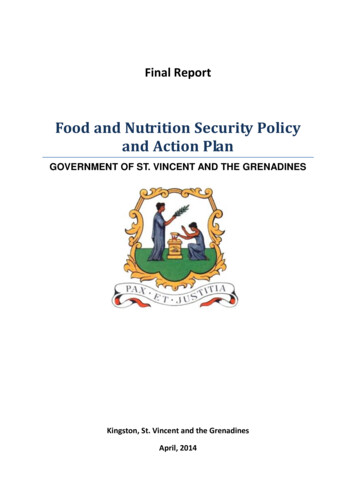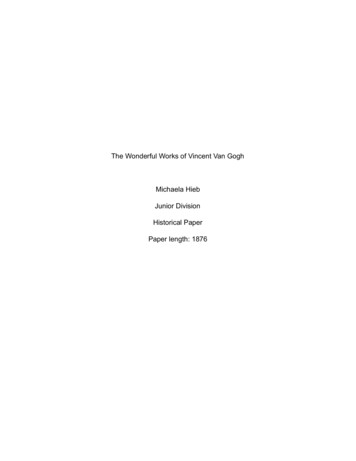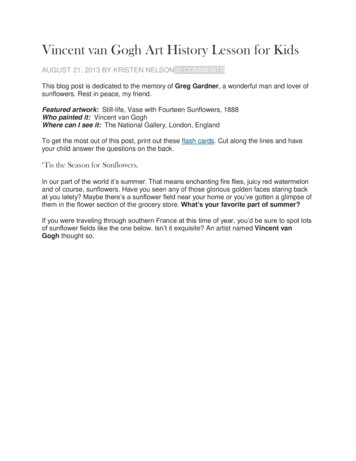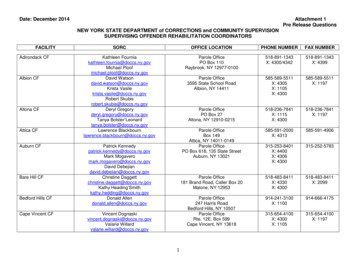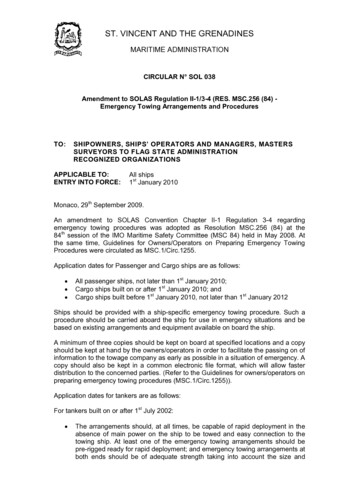
Transcription
ST. VINCENT AND THE GRENADINESMARITIME ADMINISTRATIONCIRCULAR N SOL 038Amendment to SOLAS Regulation II-1/3-4 (RES. MSC.256 (84) Emergency Towing Arrangements and ProceduresTO:SHIPOWNERS, SHIPS’ OPERATORS AND MANAGERS, MASTERSSURVEYORS TO FLAG STATE ADMINISTRATIONRECOGNIZED ORGANIZATIONSAPPLICABLE TO:ENTRY INTO FORCE:All ships1st January 2010Monaco, 29th September 2009.An amendment to SOLAS Convention Chapter II-1 Regulation 3-4 regardingemergency towing procedures was adopted as Resolution MSC.256 (84) at the84th session of the IMO Maritime Safety Committee (MSC 84) held in May 2008. Atthe same time, Guidelines for Owners/Operators on Preparing Emergency TowingProcedures were circulated as MSC.1/Circ.1255.Application dates for Passenger and Cargo ships are as follows: All passenger ships, not later than 1st January 2010;Cargo ships built on or after 1st January 2010; andCargo ships built before 1st January 2010, not later than 1st January 2012Ships should be provided with a ship-specific emergency towing procedure. Such aprocedure should be carried aboard the ship for use in emergency situations and bebased on existing arrangements and equipment available on board the ship.A minimum of three copies should be kept on board at specified locations and a copyshould be kept at hand by the owners/operators in order to facilitate the passing on ofinformation to the towage company as early as possible in a situation of emergency. Acopy should also be kept in a common electronic file format, which will allow fasterdistribution to the concerned parties. (Refer to the Guidelines for owners/operators onpreparing emergency towing procedures (MSC.1/Circ.1255)).Application dates for tankers are as follows:For tankers built on or after 1st July 2002: The arrangements should, at all times, be capable of rapid deployment in theabsence of main power on the ship to be towed and easy connection to thetowing ship. At least one of the emergency towing arrangements should bepre-rigged ready for rapid deployment; and emergency towing arrangements atboth ends should be of adequate strength taking into account the size and
deadweight of the ship, and the expected forces during bad weatherconditions. The design and construction and prototype testing of emergencytowing arrangements should be approved by the Administration, based on theGuidelines developed by the Organization (MSC.35 (63), as amended). For tankers built before 1st July 2002, the design and construction ofemergency towing arrangements should be approved by the Administration,based on the Guidelines developed by the Organization (MSC.35 (63), asamended).Emergency towing arrangements should be fitted at both ends on board every tankerof not less than 20,000 tons deadweight.Approval by the Administration is delegated to Recognized Organizations to thisAdministration.Owners/Operators of St Vincent and The Grenadines ships are requested to timelyprovide their ships with a ship-specific emergency towing procedure which should becarried aboard the ship for use in emergency situations and should be based onexisting arrangements and equipment available on board the ship. In this respectMSC.1/Circ.1255, MSC.256 (84), MSC/Circ.1175 and MSC.35 (63) are annexed tothis circular as guidelines.The procedures should be considered as part of the emergency preparednessrequired by paragraph 8 of part A of the International Safety Management (ISM)Code.
ContentListPrintTitlePage 1 of 4CIRCULAR / MSC.1/Circ.1255Refer to 08 SOLAS Reg.II-1/3-4 (Emergency towing arrangements and procedures)MSC.1/Circ.125527 May 2008GUIDELINES FOR OWNERS/OPERATORS ON PREPARING EMERGENCY TOWINGPROCEDURES1 The Maritime Safety Committee, at its eighty-fourth session (7 to 16 May 2008), following a recommendation of thefiftieth session of the Sub-Committee on Ship Design and Equipment, approved Guidelines for owners/operators onpreparing emergency towing procedures, set out in the annex, aimed at assisting owners/operators in preparing shipspecific emergency towing procedures for ships subject to SOLAS regulation II-1/3-4.2 The Guidelines are intended to help owners/operators to carry out the necessary steps in establishing emergencytowing procedures, provide information on the scope of the emergency towing booklet and give guidance towardscreating procedures for towage.3 The procedures developed by means of these Guidelines aim at supporting the crew in establishing the safest andmost efficient course of action to be taken when confronted with an emergency that requires towing.4 Member Governments are invited to bring the annexed Guidelines to the attention of all parties concerned forapplication in conjunction with SOLAS regulation II-1/3-4 (Emergency towing arrangements and procedures).***ANNEXGUIDELINES FOR OWNERS/OPERATORS ON PREPARING EMERGENCY TOWINGPROCEDURES1 PURPOSEThe purpose of these Guidelines is to assist owners/operators in preparing ship-specific emergency towing proceduresfor ships subject to SOLAS regulation II-1/3-4. The procedures should be considered as part of the emergencypreparedness required by paragraph 8 of part A of the International Safety Management (ISM) Code.2 OBSERVATIONS2.1 Owners, operators and crews should take into consideration that the nature of an emergency does not allow timefor deliberation. Accordingly, the procedures should be practiced beforehand.2.2 The towing procedures should be maintained on board the ship for ready use by the ship’s crew in preparingtheir ship for towage in an emergency.2.3 The crew should have good knowledge of equipment stowage location and accessibility . Any identifiedimprovements to stowage arrangements should be implemented.2.4 Crew dealing with an emergency situation should be aware of power availability required for winches and tools,as well as for deck lighting (for bad/low visibility and night time situations).2.5 It is recognized that not all ships will have the same degree of shipboard equipment, so that there may be limitsto possible towing procedures. Nevertheless, the intention is to predetermine what can be accomplished, andprovide this information to the ship’s crew in a ready-to-use format (booklet, plans, poster, etc.).3 SHIP tPrint.aspx?CategoryID 4778615/09/2009
ContentListPrintPage 2 of 43.1 The owner/operator should ensure that the ship is inspected and its capability to be towed under emergencysituations is evaluated. Both equipment on board and available procedures should be reviewed. Items that need tobe inspected are described in the following paragraphs.3.2 The ability of the ship to be towed from bow and stern should be evaluated, and the following items should bereviewed:.1 line handling procedures (passing and receiving messenger lines, towlines, bridles); and.2 layout, structural adequacy and safe working loads of connection points (fairleads chocks, winches, bitts,bollards), etc.3.3 The on-board tools and equipment available for assembling the towing gear and their locations should beidentified. These should include but not be limited to:.1 chains;.2 cables;.3 shackles;.4 stoppers;.5 tools; and.6 line throwing apparatus.3.4 The availability and characteristics of radio equipment on board should be identified, in order to enablecommunication between deck crew, bridge and the towing/salvage ship.3.5 Unless the safe working loads of connection points are known, these loads should be determined by anengineering analysis reflecting the on-board conditions of the ship. The Guidance on shipboard towing and mooringequipment (MSC/Circ.1175) may be used for guidance.3.6 The evaluation should be performed by persons knowledgeable in towing equipment and operations.4 EMERGENCY TOWING BOOKLET4.1 The Emergency Towing Booklet (ETB) should be ship specific and be presented in a clear, concise and ready-touse format (booklet, plan, poster, etc.).4.2 Ship-specific data should include but not be limited to:.1 ship’s name;.2 call sign;.3 IMO number;.4 anchor details (shackle, connection details, weight, type, etc.);.5 cable and chain details (lengths, connection details, proof load, etc.);.6 height of mooring deck(s) above base;.7 draft range; aspx?CategoryID 4778615/09/2009
ContentListPrintPage 3 of 4.8 displacement range.4.3 All procedures developed in accordance with section 5 should be presented in a clear and easy to understandformat, which will aid their smooth and swift application in an emergency situation.4.4 Comprehensive diagrams and sketches should be available and include the following:.1 assembly and rigging diagrams;.2 towing equipment and strong point locations; and.3 equipment and strong point capacities and safe working loads (SWLs).4.5 A copy should be kept at hand by the owners/operators in order to facilitate the passing on of information to thetowage company as early as possible in the emergency. A copy should also be kept in a common electronic fileformat, which will allow faster distribution to the concerned parties.4.6 A minimum of three copies should be kept on board and located in:.1 the bridge;.2 a forecastle space; and.3 the ship’s office or cargo control room.5 DEVELOPING PROCEDURES5.1 Ship-specific procedures should be identified during the ship’s evaluation and entered accordingly in the ETB.The procedures should include, as a minimum, the following:.1 a quick-reference decision matrix that summarizes options under various emergency scenarios, such asweather conditions (mild, severe), availability of shipboard power (propulsion, on-deck power), imminent dangerof grounding, etc.;.2 organization of deck crew (personnel distribution, equipment distribution, including radios, safety equipment,etc.);.3 organization of tasks (what needs to be done, how it should be done, what is needed for each task, etc.);.4 diagrams for assembling and rigging bridles, tow lines, etc., showing possible emergency towing arrangementsfor both fore and aft. Rigged lines should be lead such that they avoid sharp corners, edges and other points ofstress concentration;.5 power shortages and dead ship situations, which must be taken into account, especially for the heaving acrossof heavy towing lines;.6 a communications plan for contacting the salvage/towing ship . This plan should list all information that theship’s master needs to communicate to the salvage/towing ship. This list should include but not be limited to:.1 damage or seaworthiness;.2 status of ship steering;.3 propulsion;.4 on deck power rint.aspx?CategoryID 4778615/09/2009
ContentListPrintPage 4 of 4.5 on-board towing equipment;.6 existing emergency rapid disconnection system;.7 forward and aft towing point locations;.8 equipment, connection points, strong points and safe working loads (SWL);.9 towing equipment dimensions and capacities; and.10 ship particulars;.7 evaluation of existing equipment, tools and arrangements on board the ship for possible use in rigging atowing bridle and securing a towline;.8 identification of any minor tools or equipment providing significant improvements to the “towability” of the ship;.9 inventory and location of equipment on board that can be used during an emergency towing situation;.10 other preparations (locking rudder and propeller shaft, ballast and trim, etc.); and.11 other relevant information (limiting sea states, towing speeds, nt.aspx?CategoryID 4778615/09/2009
ContentListPrintPage 1 of 4TitleRes / MSC / Res.MSC.35(63)Amendment StatusAmended by Res.MSC.132(75), Supersedes Res.A.535(13)RESOLUTION MSC.35(63)(adopted on 20 May 1994)ADOPTION OF GUIDELINES FOR EMERGENCY TOWING ARRANGEMENTS ONTANKERSTHE MARITIME SAFETY COMMITTEE,RECALLING Article 28(b) of the Convention on the International Maritime Organization concerning the functions ofthe Committee,RECALLING ALSO that the Assembly, at its thirteenth session, when adopting resolution A.535(13) concerningRecommendation on emergency towing requirements for tankers, requested the Committee to keep theRecommendation under review, in particular in respect to new towing concepts which may be introduced and toreport as necessary to the Assembly,NOTING that tankers, including oil tankers, gas carriers and chemical tankers, in emergencies such as completemechanical breakdowns, may need to be towed out of danger, and that technologically advanced towingarrangements have been developed since the adoption of resolution A.535(13), whose provisions need revision toincorporate new towing concepts,NOTHING ALSO that the new regulation V/15-1 of the International Convention for the Safety of Life at Sea, 1974,as adopted by the Committee in May 1994, requires that all tankers of not less than 20,000 tonnes deadweight shallbe fitted with an emergency towing arrangement, the design and construction of which shall be approved by theAdministration based on the Guidelines developed by the Organization,HAVING CONSIDERED the recommendation made by the Sub-Committee on Ship Design and Equipment at itsthirty-seventh session,1. ADOPTS the Guidelines for Emergency Towing Arrangements on Tankers, the text of which is set out in the Annex tothe present resolution and which supersedes resolution A.535(13) ;2. RECOMMENDS that all Governments concerned take appropriate steps to implement the Guidelines.ANNEXGUIDELINES FOR EMERGENCY TOWING ARRANGEMENTS ON TANKERS1. PURPOSE1.1 Under regulation V/15-1 of the 1974 SOLAS Convention, as amended by resolution MSC.31(63) in 1994, newand existing tankers of 20,000 tonnes deadweight and above shall be fitted with an emergency towing arrangement,the design and construction of which shall be approved by the Administration, based on the Guidelines developed bythe ListPrint.aspx?CategoryID 746516/09/2009
ContentListPrintPage 2 of 41.2 The present Guidelines are intended to provide standards for the design and construction of emergency towingarrangements which Administrations are recommended to implement.1.3 For existing tankers fitted with the emergency towing arrangements in accordance with resolution A.535(13), theexisting towing arrangements forward of the ship may be retained, but the towing arrangements aft of the ship shouldbe upgraded to comply with the requirements of the present Guidelines.2 REQUIREMENTS FOR THE ARRANGEMENTS AND COMPONENTS2.1 GeneralThe emergency towing arrangements should be so designed as to facilitate salvage and emergency towingoperations on tankers primarily to reduce the risk of pollution. The arrangements should at all times be capable ofrapid deployment in the absence of main power on the ship to be towed and easy connection to the towingvessel. Figure 1 shows arrangements which may be used as reference.2.2 Towing componentsPick-up gearTowing pennantChafing gearFairleadStrongpointRoller pedestalForward of ship*optionaloptionalYesYesYesYesAft of shipYesYesDepending on designYesYesDepending on designStrength requirements--YesYesYesYes---The major components of the towing arrangements should consist of the following:* See paragraph 3.1.4.2.3 Strength of the towing components2.3.1 Towing components as specified in 2.2 for strength should have a working strength of at least 1,000 kN fortankers of 20,000 tonnes deadweight and over but less than 50,000 tonnes deadweight and at least 2,000 kN fortankers of 50,000 tonnes deadweight and over(working strength is defined as one half ultimate strength). Thestrength should be sufficient for all relevant angles of towline, i.e. up to 90 from the ship's centreline to port andstarboard and 30 vertical downwards.2.3.2 Other components should have a working strength sufficient to withstand the load to which suchcomponents may be subjected during the towing operation.2.4 Length of towing pennantThe towing pennant should have a length of at least twice the lightest seagoing ballast freeboard at the fairleadplus 50 m.2.5 Location of strongpoint and fairleadThe bow and stern strongpoint and fairleads should be located so as to facilitate towing from either side of thebow or stern and minimize the stress on the towing system.2.6 StrongpointThe inboard end fastening should be a stopper or bracket or other fitting of equivalent strength. The strongpointcan be designed integral with the fairlead.2.7 Fairleads2.7.1 SizeFairleads should have an opening large enough to pass the largest portion of the chafing gear, nt.aspx?CategoryID 746516/09/2009
ContentListPrintPage 3 of 4pennant or towing line.2.7.2 GeometryThe fairlead should give adequate support for the towing pennant during towing operation which meansbending 90 to port and to starboard side and 30 vertical downwards. The vending ratio(towing pennantbearing surface diameter to towing pennant diameter should be not less than 7 to 1.2.7.3 Vertical locationThe fairlead should be located as close as possible to the deck and, in any case, in such a position that thechafing chain is approximately parallel to the deck when it is under strain between the strongpoint and thefairlead.2.8 Chafing chainDifferent solutions on design of chafing gear can be used. If a chafing chain is to be used, it should have thefollowing characteristics:2.8.1 TypeThe chafing chain should be stud link chain.2.8.2 LengthThe chafing chain should be long enough to ensure that the towing pennant remains outside the fairleadduring the towing operation. A chain extending from the strongpoint to a point at least 3 m beyond the fairleadshould meet this criterion.2.8.3 Connecting limitsOne end of the chafing chain should be suitable for connection to the strongpoint. The other end should befitted with a standard pear-shaped open link allowing connection to a standard bow shackle.2.8.4 StowageThe chafing chain should be stowed in such a way that it can be rapidly connected to the strongpoint.2.9 Towing connectionThe towing pennant should have a hard eye-formed termination allowing connection to a standard bowshackle.2.10 Prototype test (Refer to the IACS UI SC113)Designs of emergency towing arrangements in accordance with these Guidelines should be prototype tested tothe satisfaction of the Administration.3 READY AVAILABILITY OF TOWING ARRANGEMENTS3.1 To facilitate approval of such equipment and to ensure rapid deployment, emergency towing arrangementsshould comply with the following criteria:.1 The aft emergency towing arrangement should be pre-rigged and be capable of being deployed in a controlledmanner in harbour conditions in not more than 15 min.2 The pick-up gear for the aft towing pennant should be designed at least for manual operation by one persontaking into account the absence of power and the potential for adverse environmental conditions that may int.aspx?CategoryID 746516/09/2009
ContentListPrintPage 4 of 4during such emergency towing operations. The pick-up gear should be protected against the weather and otheradverse conditions that may prevail.3 The forward emergency towing arrangement should be capable of being deployed in harbour conditions in notmore than 1 h.4 The forward emergency towing arrangement should be designed at least with a means of securing a towline tothe chafing gear using a suitably positioned pedestal toller to facilitate connection of the towing pennant.5 Forward emergency towing arrangements which comply with the requirements for aft emergency towingarrangements may be accepted.6 All emergency towing arrangements should be clearly marked to facilitate safe and effective use even indarkness and poor visibility.3.2 All emergency towing components should be inspected by ship personnel at regular intervals and maintained ingood working Print.aspx?CategoryID 746516/09/2009
ContentListPrintTitlePage 1 of 6Res / MSC / Res.MSC.256(84)ANNEX 2RESOLUTION MSC.256(84)(adopted on 16 May 2008)ADOPTION OF AMENDMENTS TO THE INTERNATIONAL CONVENTION FOR THESAFETY OF LIFE AT SEA, 1974, AS AMENDEDTHE MARITIME SAFETY COMMITTEE,RECALLING Article 28(b) of the Convention on the International Maritime Organization concerning the functions of theCommittee,RECALLING FURTHER article VIII(b) of the International Convention for the Safety of Life at Sea (SOLAS), 1974(hereinafter referred to as “the Convention”), concerning the amendment procedure applicable to the Annex to theConvention, other than to the provisions of chapter I thereof,HAVING CONSIDERED, at its eighty-fourth session, amendments to the Convention, proposed and circulated inaccordance with article VIII(b)(i) thereof,1. ADOPTS, in accordance with article VIII(b)(iv) of the Convention, amendments to the Convention, the text of whichis set out in the Annex to the present resolution;2. DETERMINES, in accordance with article VIII(b)(vi)(2)(bb) of the Convention, that the said amendments shall bedeemed to have been accepted on 1 July 2009, unless, prior to that date, more than one third of the ContractingGovernments to the Convention or Contracting Governments the combined merchant fleets of which constitute notless than 50% of the gross tonnage of the world’s merchant fleet, have notified their objections to the amendments;3. INVITES SOLAS Contracting Governments to note that, in accordance with article VIII(b)(vii)(2) of the Convention,the amendments shall enter into force on 1 January 2010 upon their acceptance in accordance with paragraph 2above;4. RECOMMENDS the Contracting Governments concerned to issue certificates complying with the annexedamendments at the first renewal survey on or after 1 January 2010;5. REQUESTS the Secretary-General, in conformity with article VIII(b)(v) of the Convention, to transmit certifiedcopies of the present resolution and the text of the amendments contained in the annex to all ContractingGovernments to the Convention;6. FURTHER REQUESTS the Secretary-General to transmit copies of this resolution and its Annex to Members ofthe Organization, which are not Contracting Governments to the Convention.ANNEXAMENDMENTS TO THE INTERNATIONAL CONVENTION FOR THE SAFETY OF LIFEAT SEA, 1974, AS AMENDEDCHAPTER II-1CONSTRUCTION - STRUCTURE, SUBDIVISION AND STABILITY, MACHINERY ANDELECTRICAL INSTALLATIONSRegulation 3-4 - Emergency towing arrangements on tankers1 The existing regulation 3-4 is replaced by the tPrint.aspx?CategoryID 4776015/09/2009
ContentListPrintPage 2 of 6“Regulation 3-4 Emergency towing arrangements and procedures1 Emergency towing arrangements on tankers1.1 Emergency towing arrangements shall be fitted at both ends on board every tanker of not less than 20,000tonnes deadweight.1.2 For tankers constructed on or after 1 July 2002:.1 the arrangements shall, at all times, be capable of rapid deployment in the absence of main power on theship to be towed and easy connection to the towing ship. At least one of the emergency towing arrangementsshall be pre-rigged ready for rapid deployment; and.2 emergency towing arrangements at both ends shall be of adequate strength taking into account the sizeand deadweight of the ship, and the expected forces during bad weather conditions. The design andconstruction and prototype testing of emergency towing arrangements shall be approved by theAdministration, based on the Guidelines developed by the Organization*.1.3 For tankers constructed before 1 July 2002, the design and construction of emergency towing arrangementsshall be approved by the Administration, based on the Guidelines developed by the Organization*.* Refer to the Guidelines on emergency towing arrangements for tankers, adopted by the Maritime Safety Committeeby resolution MSC.35(63), as amended.2 Emergency towing procedures on ships2.1 This paragraph applies to:.1 all passenger ships, not later than 1 January 2010;.2 cargo ships constructed on or after 1 January 2010; and.3 cargo ships constructed before 1 January 2010, not later than 1 January 2012.2.2 Ships shall be provided with a ship-specific emergency towing procedure. Such a procedure shall be carriedaboard the ship for use in emergency situations and shall be based on existing arrangements and equipmentavailable on board the ship.2.3 The procedure** shall include:** Refer to the Guidelines for owners/operators on preparing emergency towing procedures (MSC.1/Circ.1255).1 drawings of fore and aft deck showing possible emergency towing arrangements;.2 inventory of equipment on board that can be used for emergency towing;.3 means and methods of communication; and.4 sample procedures to facilitate the preparation for and conducting of emergency towing operations.”2 The following new regulation 3-9 is added after the existing regulation 3-8:“Regulation 3-9 Means of embarkation on and disembarkation from ships1 Ships constructed on or after 1 January 2010 shall be provided with means of embarkation on and sListPrint.aspx?CategoryID 4776015/09/2009
ContentListPrintPage 3 of 6from ships for use in port and in port related operations, such as gangways and accommodation ladders, inaccordance with paragraph 2, unless the Administration deems that compliance with a particular provision isunreasonable or impractical*.* Circumstances where compliance may be deemed unreasonable or impractical may include where the ship:.1 has small freeboards and is provided with boarding ramps; or.2 is engaged in voyages between designated ports where appropriate shore accommodation/embarkation ladders(platforms) are provided.2 The means of embarkation and disembarkation required in paragraph 1 shall be constructed and installed basedon the guidelines developed by the Organization**.3 For all ships the means of embarkation and disembarkation shall be inspected and maintained** in suitablecondition for their intended purpose, taking into account any restrictions related to safe loading. All wires used tosupport the means of embarkation and disembarkation shall be maintained as specified in regulation III/20.4.”** Refer to the Guidelines for construction, installation, maintenance and inspection/survey of accommodationladders and gangways, to be developed by the Organization.CHAPTER II-2CONSTRUCTION - FIRE PROTECTION, FIRE DETECTION AND FIRE EXTINCTIONRegulation 10 - Fire fighting3 The following new paragraph 4.1.5 is added after the existing paragraph 4.1.4:“4.1.5 By the first scheduled dry-docking after 1 January 2010, fixed carbon dioxide fire-extinguishing systems forthe protection of machinery spaces and cargo pump-rooms on ships constructed before 1 July 2002 shall complywith the provisions of paragraph 2.2.2 of chapter 5 of the Fire Safety Systems Code.”Regulation 19 - Carriage of dangerous goods4 In paragraph 4, the words “, as defined in regulation VII/2,” are deleted.Regulation 20 - Protection of vehicle, special category and ro-ro spaces5 The existing paragraph 6.1.4 is replaced by the following paragraph 6.1.4 and new paragraph 6.1.5 is added afterparagraph 6.1.4 as follows:“6.1.4 The requirement of this paragraph shall apply to ships constructed on or after 1 January 2010. Shipsconstructed on or after 1 July 2002 and before 1 January 2010 shall comply with the previously applicablerequirements of paragraph 6.1.4, as amended by resolution MSC.99(73). When fixed pressure watersprayingsystems are fitted, in view of the serious loss of stability which could arise due to large quantities of wateraccumulating on the deck or decks during the operation of the fixed pressure water-spraying system, thefollowing arrangements shall be provided:.1 in passenger ships:.1.1 in the spaces above the bulkhead deck, scuppers shall be fitted so as to ensure that such water israpidly discharged directly overboard, taking into account the guidelines developed by the Organization*;.1.2.1 in ro-ro passenger ships, discharge valves for scuppers, fitted with positive means of closingoperable from a position above the bulkhead deck in accordance with the requirements of theInternational Convention on Load Lines in force, shall be kept open while the ships are at sea;.1.2.2 any operation of valves referred to in paragraph 6.1.4.1.2.1 shall be recorded in the log-book;.1.3 in the spaces below the bulkhead deck, the Administration may require pumping and rint.aspx?CategoryID 4776015/09/2009
ContentListPrintPage 4 of 6facilities to be provided additional to the requirements of regulation II-1/35-1. In such case, the drainagesystem shall be sized to remove no less than 125% of the combined capacity of both the water-sprayingsystem pumps and the required number of fire hose nozzles, taking into account the guidelinesdeveloped by the Organization*. The drainage system valves shall be operable from outside the protectedspace at a position in the vicinity of the extinguishing system controls. Bilge wells shall be of sufficientholding capacity and shall be arranged at the side shell of the ship at a distance from each other of notmore than 40 m in each watertight compartment;.2 in cargo ships, the drainage and pumping arrangements shall be such as to prevent the build-up of freesurfaces. In such case, the drainage system shall be sized to remove no less than 125% of the combinedcapacity of both the water-spraying system pumps and the required number of fire hose nozzles, taking intoaccount the guidelines developed by the Organization*. The drainage system valves shall be operable fromoutside the protected space at a position in the vicinity of the extinguishing system controls. Bilge wells shallbe of sufficient holding capacity and shall be arranged at the side shell of the ship at a distance from e
ST. VINCENT AND THE GRENADINES MARITIME ADMINISTRATION CIRCULAR N SOL 038 Amendment to SOLAS Regulation II-1/3-4 (RES. MSC.256 (84) - Emergency Towing Arrangements and Procedures TO: SHIPOWNERS, SHIPS' OPERATORS AND MANAGERS, MASTERS SURVEYORS TO FLAG STATE ADMINISTRATION RECOGNIZED ORGANIZATIONS APPLICABLE TO: All ships ENTRY INTO FORCE: 1stJanuary2010 Monaco, 29th September2009. An .



